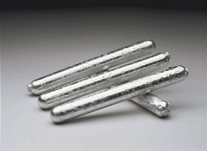cadmium

Cadmium. Credit: Lenntech Corp.
Cadmium (Cd) is a soft, silvery-white, malleable and ductile, metallic element and anomalous transition element, found in group IIB of the periodic table. It was first isolated by Fredrich Stromeyer in Göttingen, Germany, in 1817. The name comes from the Latin cadmia, the name for the mineral calomine. It is found in the mineral greenockite (a sulfide) but is chiefly obtained as a by-product in the extraction of zinc and lead. Cadmium sulfide, prepared artificially, is bright yellow in color and used by artists in the form of cadmium yellow.
Cadmium is also used in the manufacture of fusible (low-melting) alloys, for electroplating to give corrosion-resistance, and in nickel-cadmium batteries. As it is a good absorber of neutrons, it is used in the manufacture of control rods for nuclear reactors. Chemically, it resembles zinc but forms more complex compounds. Its most common isotope is cadmium-114 (28.86 percent).
| atomic number | 48 |
| relative atomic mass | 112.4 |
| relative density | 8.65 |
| melting point | 320.9°C (609.6°F) |
| boiling point | 765°C (1,409°F) |
| electronegativity | 1.7 |
| electron configuration | [Kr] 4d105s2 |
| first ionization potential | 866 kJ.mol-1 |
| second ionization potential | 1,622 kJ.mol-1 |
Cadmium poisoning
Cadmium accumulates in the body (especially in the kidneys): although a person's daily intake may be as little as 0.05 milligram, he or she will have stored, on average about 50 milligrams. Cadmium is a poison, a carcinogen, and is known to cause birth defects.
Poisoning due to inhalation of cadmium dust or fumes is an industrial hazard, the effects of which vary according to the duration and severity of exposure. Acute exposure may lead to pneumonitis (inflammation of the lungs). Exposure over a long period can lead to urinary tract calculi (stones), kidney failure, or emphysema.
Cadmium poisoning may also be caused by eating vegetables grown in cadmium-rich soil or by consuming food or drink that has been stored in cadmium-lined containers.


